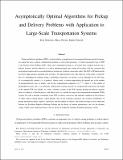| dc.contributor.author | Pavone, Marco | |
| dc.contributor.author | Frazzoli, Emilio | |
| dc.contributor.author | Treleaven, Kyle Ballantyne | |
| dc.date.accessioned | 2013-10-25T14:13:47Z | |
| dc.date.available | 2013-10-25T14:13:47Z | |
| dc.date.issued | 2013-08 | |
| dc.date.submitted | 2013-03 | |
| dc.identifier.issn | 0018-9286 | |
| dc.identifier.issn | 1558-2523 | |
| dc.identifier.uri | http://hdl.handle.net/1721.1/81773 | |
| dc.description.abstract | Pickup and delivery problems (PDPs), in which objects or people have to be transported between specific locations, are among the most common combinatorial problems in real-world logistical operations. A widely-encountered type of PDP is the Stacker Crane Problem (SCP), where each commodity/customer is associated with a pickup location and a delivery location, and the objective is to find a minimum-length tour visiting all locations with the constraint that each pickup location and its associated delivery location are visited in immediate, consecutive order. The SCP is NP-Hard and the best known approximation algorithm only provides a 9/5 approximation ratio. In this paper, we examine an embedding of the SCP within a stochastic framework, and our objective is three-fold: First, we describe a large class of algorithms for the SCP, where every member is asymptotically optimal, i.e., it produces, almost surely, a solution approaching the optimal one as the number of pickups/deliveries goes to infinity; moreover, one can achieve computational complexity O(n[superscript 2+ε]) within the class, where n is the number of pickup/delivery pairs and ε is an arbitrarily small positive constant. Second, we characterize the length of the optimal SCP tour asymptotically. Finally, we study a dynamic version of the SCP, whereby pickup and delivery requests arrive according to a Poisson process, and which serves as a model for large-scale demand-responsive transport (DRT) systems. For such a dynamic counterpart of the SCP, we derive a necessary and sufficient condition for the existence of stable vehicle routing policies, which depends only on the workspace geometry, the distributions of pickup and delivery points, the arrival rate of requests, and the number of vehicles. Our results leverage a novel connection between the Euclidean Bipartite Matching Problem and the theory of random permutations, and, for the dynamic setting, exhibit novel features that are absent in traditional spatially-distributed queueing systems. | en_US |
| dc.description.sponsorship | Singapore-MIT Alliance for Research and Technology Center | en_US |
| dc.language.iso | en_US | |
| dc.publisher | Institute of Electrical and Electronics Engineers (IEEE) | en_US |
| dc.relation.isversionof | http://dx.doi.org/10.1109/tac.2013.2259993 | en_US |
| dc.rights | Creative Commons Attribution-Noncommercial-Share Alike 3.0 | en_US |
| dc.rights.uri | http://creativecommons.org/licenses/by-nc-sa/3.0/ | en_US |
| dc.source | MIT web domain | en_US |
| dc.title | Asymptotically Optimal Algorithms for One-to-One Pickup and Delivery Problems With Applications to Transportation Systems | en_US |
| dc.type | Article | en_US |
| dc.identifier.citation | Treleaven, Kyle, Marco Pavone, and Emilio Frazzoli. “Asymptotically Optimal Algorithms for One-to-One Pickup and Delivery Problems With Applications to Transportation Systems.” IEEE Transactions on Automatic Control 58, no. 9 (September 2013): 2261-2276. | en_US |
| dc.contributor.department | Massachusetts Institute of Technology. Department of Aeronautics and Astronautics | en_US |
| dc.contributor.department | Massachusetts Institute of Technology. Laboratory for Information and Decision Systems | en_US |
| dc.contributor.mitauthor | Treleaven, Kyle Ballantyne | en_US |
| dc.contributor.mitauthor | Frazzoli, Emilio | en_US |
| dc.relation.journal | IEEE Transactions on Automatic Control | en_US |
| dc.eprint.version | Author's final manuscript | en_US |
| dc.type.uri | http://purl.org/eprint/type/JournalArticle | en_US |
| eprint.status | http://purl.org/eprint/status/PeerReviewed | en_US |
| dspace.orderedauthors | Treleaven, Kyle; Pavone, Marco; Frazzoli, Emilio | en_US |
| dc.identifier.orcid | https://orcid.org/0000-0002-0505-1400 | |
| mit.license | OPEN_ACCESS_POLICY | en_US |
| mit.metadata.status | Complete | |
